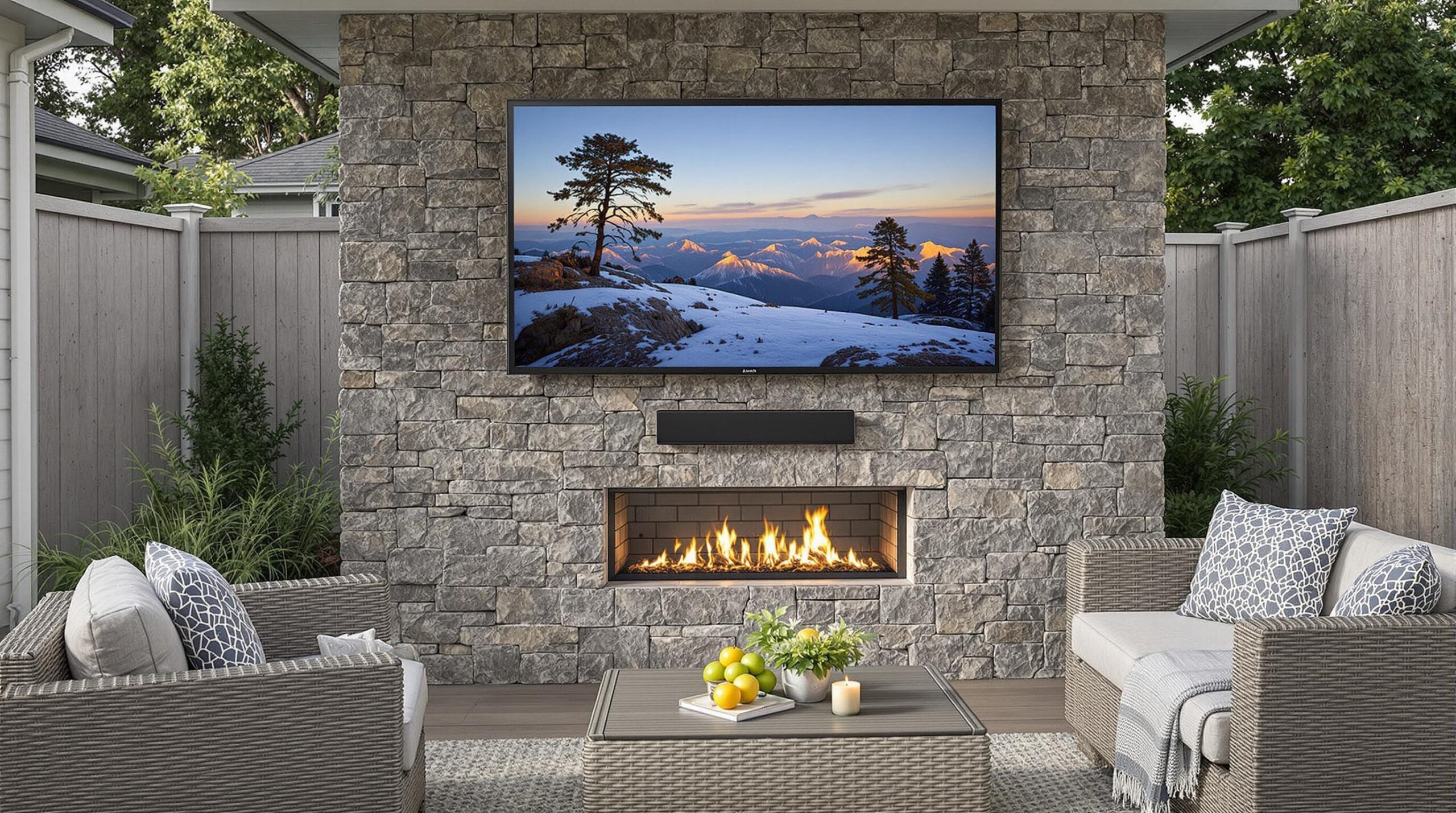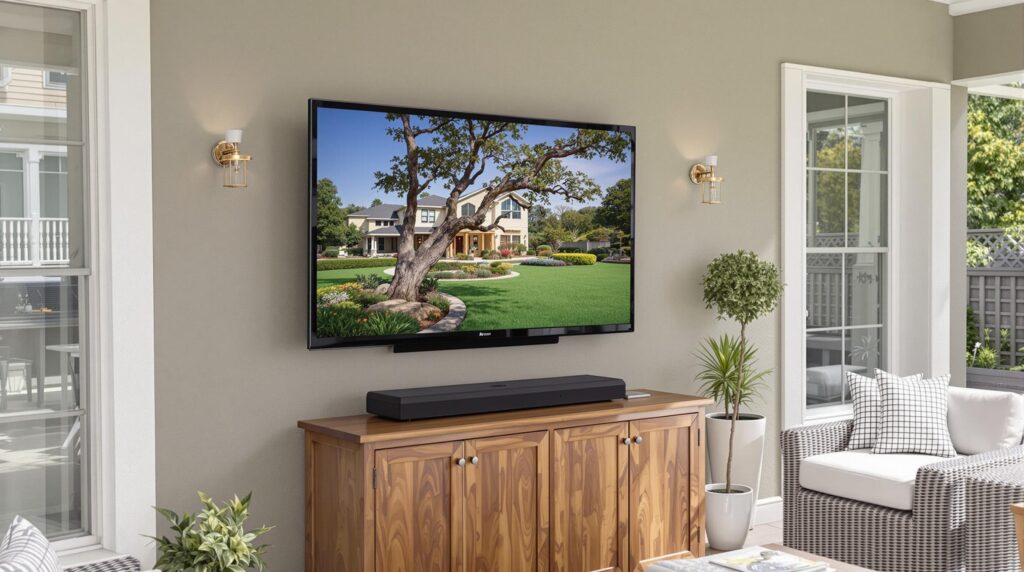Outdoor TVs have revolutionized backyard entertainment, allowing homeowners to enjoy their favorite shows and sports while soaking up the sun or hosting evening gatherings. Unlike regular televisions, outdoor TVs are specifically engineered to withstand environmental challenges such as rain, dust, extreme temperatures, and glare, making them a perfect addition to patios, decks, and poolside areas.
Key Takeaways
- Outdoor TVs require special weatherproofing features including temperature resistance, waterproofing, and anti-glare technology
- Consider your specific environment when selecting brightness levels (partial shade: 400-700 nits, full sun: 1000+ nits)
- Look for TVs with proper IP ratings (IP55 or higher) to ensure protection against dust and water
- Installation location affects both viewing experience and the TV’s exposure to elements
- Budget accordingly as outdoor TVs typically cost 2-3 times more than comparable indoor models
Why Regular TVs Don’t Work Outdoors
Many homeowners make the costly mistake of installing a regular indoor television in their outdoor space. Standard TVs simply aren’t built to handle the harsh outdoor conditions that an outdoor TV is designed to withstand. Regular televisions lack proper sealing against moisture, which can lead to internal condensation and electrical failures when exposed to humidity or rain.
Temperature fluctuations pose another significant risk. Most indoor TVs are designed to operate between 40°F and 95°F, while outdoor environments can easily exceed these limits. The sun’s UV rays can damage the display panel, causing color fading and reduced visibility. Additionally, standard TVs typically have brightness levels around 250-350 nits, making them nearly impossible to view clearly in bright outdoor settings.

Key Features to Look for in an Outdoor TV
When shopping for an outdoor TV, several critical specifications deserve your attention. These features determine not only how well your TV will perform but also how long it will last in outdoor conditions.
Weatherproofing is essential for any outdoor television. Look for models with an IP (Ingress Protection) rating of at least IP55, which indicates strong protection against dust and water jets from any direction. Higher-end models may offer IP66 or even IP67 ratings for superior environmental protection.
Brightness levels directly impact visibility in outdoor settings. For partially shaded areas like covered patios, TVs with 400-700 nits brightness will suffice. However, for areas with direct sunlight, I recommend models offering 1,000+ nits to combat glare and ensure a clear picture even on bright days.
Temperature resistance is another crucial factor. Quality outdoor TVs are designed to function in extreme temperatures, typically ranging from -20°F to 120°F. This wide operating range ensures your entertainment continues uninterrupted regardless of season or weather conditions.
Understanding Brightness Requirements for Different Outdoor Spaces
The brightness requirements for your outdoor TV will vary significantly depending on where you plan to install it. This is measured in nits, which indicate the amount of light the screen emits.
For fully shaded areas like covered porches or gazebos, a TV with 400-500 nits will provide adequate visibility. These areas are protected from direct sunlight, making them the most forgiving environment for outdoor viewing.
Partial shade locations require more brightness to overcome ambient light. TVs with 700-900 nits work well in these mixed-light environments, providing enough illumination to maintain picture quality when occasional sunlight hits the screen.
For full-sun installations near pools or open patios, only the brightest outdoor TVs will suffice. Models offering 1,000-2,500 nits are necessary to combat direct sunlight and ensure visibility throughout the day. Without this level of brightness, your screen will appear washed out and difficult to see.
Size and Viewing Distance Considerations
Selecting the right size for your outdoor TV involves balancing screen dimensions with viewing distance. Unlike indoor spaces, outdoor areas often have more variable viewing positions and greater distances between viewers and the screen.
A good rule of thumb for determining optimal TV size is to measure the distance from the TV to the primary viewing area in inches, then divide by 1.5 to 2.5. For example, if your outdoor seating is 120 inches (10 feet) from the TV location, you’d want a screen between 48 and 80 inches.
Consider these recommended screen sizes based on viewing distance:
- 5-8 feet: 43-55 inch TV
- 8-10 feet: 55-65 inch TV
- 10-12 feet: 65-75 inch TV
- 12+ feet: 75 inch or larger TV
Remember that outdoor environments often involve social gatherings with viewers at various angles. This makes viewing angle another important consideration. Look for TVs with wide viewing angles (120+ degrees) to ensure everyone can enjoy a clear picture regardless of where they’re seated.
Installation and Mounting Options
Proper installation is crucial for both the performance and longevity of your outdoor TV. The mounting location affects everything from viewing comfort to protection from elements.
Wall mounting remains the most popular option, particularly on exterior home walls or solid patio structures. When wall mounting, use weatherproof, rust-resistant hardware designed specifically for outdoor use. I recommend installing the TV under some form of coverage whenever possible, even if the TV is fully weatherproof.
Ceiling mounts work well for covered patios or pergolas, allowing the TV to be suspended at an optimal viewing height. These installations typically require professional help to ensure proper support and electrical connections.
For maximum flexibility, consider a movable stand or cart. These allow you to reposition your TV based on sun position or event needs. Some premium options include lockable wheels and secure anchoring systems for stability in windy conditions.
Regardless of mounting style, always ensure proper ventilation around the TV. Even weatherproof models generate heat and need airflow to prevent overheating. Additionally, plan for proper cable management to protect connections from moisture and keep your outdoor space looking neat.
Audio Considerations for Outdoor Environments
Sound quality presents unique challenges in outdoor settings. Unlike indoor spaces that contain and reflect sound, outdoor areas allow audio to dissipate quickly, potentially diminishing your viewing experience.
While most outdoor TVs include built-in speakers, these are rarely powerful enough for larger outdoor spaces. For improved audio, consider these options:
- Weatherproof soundbars specifically designed for outdoor use
- In-ceiling or wall-mounted outdoor speakers
- Landscape speaker systems that blend into garden areas
- Wireless outdoor subwoofers for enhanced bass response
When selecting audio equipment, ensure it carries appropriate weatherproofing ratings matching your TV’s protection level. Many outdoor entertainment systems now support wireless connectivity, making it easier to create a comprehensive audio setup without running excessive cables.
For the best experience, position speakers to direct sound toward the primary viewing area rather than dispersing it across the entire yard. This creates a more immersive listening environment even in open-air settings.
Smart Features and Connectivity
Today’s outdoor TVs offer many of the same smart features as their indoor counterparts, but connectivity requires special consideration in outdoor installations. Most modern outdoor TVs include built-in Wi-Fi, Bluetooth, and streaming capabilities, allowing access to popular services like Netflix, Hulu, and YouTube.
Ensure reliable Wi-Fi coverage extends to your outdoor viewing area. For locations with weak signals, consider adding a Wi-Fi extender or mesh network node to improve connectivity. Some homeowners opt for hardwired ethernet connections during installation for the most stable streaming experience, especially for TV streaming providers that require substantial bandwidth.
Voice control integration through assistants like Alexa, Google Assistant, or Siri can enhance the outdoor viewing experience, allowing hands-free operation while grilling or entertaining. Many outdoor TVs also support HDMI ARC connections for simplified audio setup with compatible soundbars.
For maximum versatility, look for models with multiple HDMI ports, USB connections, and optical audio outputs. These allow you to connect gaming consoles, streaming devices, or other media sources as needed.
Budget Considerations
Outdoor TVs represent a significant investment compared to their indoor counterparts. Due to their specialized weatherproofing, enhanced brightness, and durable construction, you can expect to pay 2-3 times more than you would for a comparable indoor model.
Entry-level outdoor TVs typically start around $1,500-2,000 for smaller sizes (43-50 inches) with basic weatherproofing suitable for shaded areas. Mid-range options with better brightness and full weatherproofing generally cost $2,500-4,000 for 55-65 inch screens.
Premium models designed for full-sun environments with the highest brightness levels and most comprehensive protection features can exceed $5,000-8,000 for larger screen sizes (65+ inches). These high-end units often include extended warranties and additional features like anti-theft systems or enhanced cooling.
Beyond the TV itself, budget for proper installation, which may include electrical work, mounting hardware, and possibly professional installation services. Additionally, consider the cost of weatherproof accessories such as outdoor-rated HDMI cables, power protection, and audio equipment.
Maintenance Tips for Outdoor TVs
Even with weatherproof design, proper maintenance will extend the life of your outdoor TV. I recommend creating a regular care routine to protect your investment.
Clean the screen periodically with a soft, damp microfiber cloth. Avoid harsh chemicals or glass cleaners, which can damage special anti-glare coatings. For stubborn spots, use only cleaners specifically approved for TV screens.
Inspect weatherproof seals and connection ports seasonally for signs of wear or damage. Many outdoor TVs include special covers for input panels that should be securely closed when ports aren’t in use.
Consider using a fitted TV cover during extended periods of non-use or extreme weather events. Even weatherproof TVs benefit from this additional protection, particularly in areas with severe weather conditions.
Check mounting hardware periodically, especially after storms or high winds, to ensure everything remains secure. Loose mounts can damage the TV and pose safety hazards.
If you live in an area with freezing winters and don’t plan to use your outdoor TV during cold months, some manufacturers recommend bringing the unit indoors or ensuring it remains powered (even on standby) to maintain internal components at safe temperatures.
Top Brands in the Outdoor TV Market
Several manufacturers have established themselves as leaders in the outdoor TV market, each with distinctive approaches to weatherproofing and display technology.
SunBrite TV pioneered the outdoor television category and remains one of



